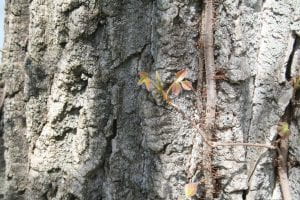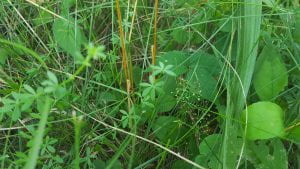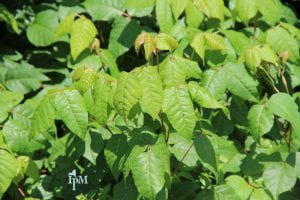“Lewis Ziska, one of the lead scientists on the six-year study in a forest at Duke University, found that with increased atmospheric CO2 we get bigger, stronger, leafier poison ivy.” – Mary Woodsen, Poison ivy (like the Rolling Stones said …)
Just what we needed. Bigger, healthier, more toxic poison ivy.
Poison ivy has a wide variety of habits – it’s often a climber with thick, woody vines. The vines are covered with rootlike hairs that help it cling to tree trunks or fences, which is a great way to distinguish it from other vines such as Virginia creeper. You will likely see this form most often on school grounds as it climbs fences, trees, and buildings.
It can also be standalone plants with a groundcover quality to them. And it can present in a shrub-like manner – most commonly seen along woodland edges.
The famous saying, “Leaves of three, let it be” is the one feature common to all growth forms. Those leaves, however, can range from ½” on new plants to over 5 inches long on older plants. They are usually smooth, but they can be toothed and sometimes lobed. Young leaves are usually reddish, older leaves can be a deep green, turning red or yellow in the fall. Shinyness is an option, therefore you can’t count on it to confirm your identification.
And sometimes, it’s just hidden. As I type this blog, my fingers are pink with calamine lotion and I am trying desperately not to rub them against my pants. After a trying day, I vented my frustration on a neglected mulched area under a tree. I noticed the small poison ivy plants tucked into the other weeds only after I had ripped them out with my bare hands. I washed my hands with soap and water to remove the offending urushiol, the toxic oil that causes the dermatitis. But I wasn’t fast enough. A few days later, here come the blisters.
So, the motivation to check the NYS IPM resources on poison ivy management was strong. Here’s what I found on the School IPM Best Practices website:
Give it a trim. Often
Poison ivy does not like to be trimmed. Mowing or cutting back young growth will deplete the energy in the roots. Plant stems, aerial vines and underground creeping stems are all capable of producing new nodes and leaves, so continue to monitor and trim. For best results, cut back new growth at the base of the plant.
Using a weed whacker is not recommended without full protective gear as plant material can be kicked back and land on exposed skin. Or in your eyes (shudder).
DO NOT BURN! The oils can be distributed through the smoke. It’s bad enough in between your fingers. You do not want to experience that kind of rash in your lungs.
Spot applications of a nonselective herbicide can be helpful for hard to reach locations or if you are extremely sensitive, but you need to follow the regulations laid out in the Child Safe Playing Fields Act and other state regulations. And remember, plants killed by herbicides will still have urushiol and can cause a rash.
In fact, the longlasting oils are present on all parts of the plant whether the plant is actively growing, dormant, or dead. So…
Wash your equipment!
Once on skin, tools, clothes, boots, and gloves, the oils need to be removed with soap and water. If you mowed poison ivy, urushiol may still be present on the mower blades the next time you remove them to sharpen them. If you used goats (yes, goats have been used to remove poison ivy), it could be in their hair. Take precautions.
And, for goodness sake, give a quick visual check before plunging into handweeding.
One last thought – according to the Cornell Lab of Ornithology, poison ivy “produces just the kind of fat-rich berries that are essential for sustaining migrating birds during fall and year-round residents in the winter”. So if you have poison ivy in an out-of-the-way area, consider leaving it behind for its wildlife value.
Now, if you will excuse me, I need to take another benadryl.



